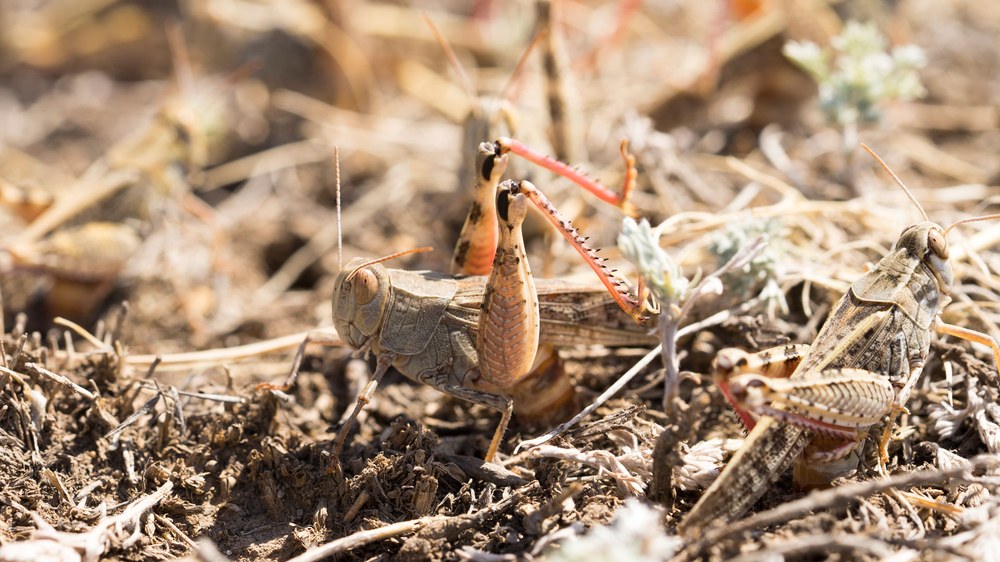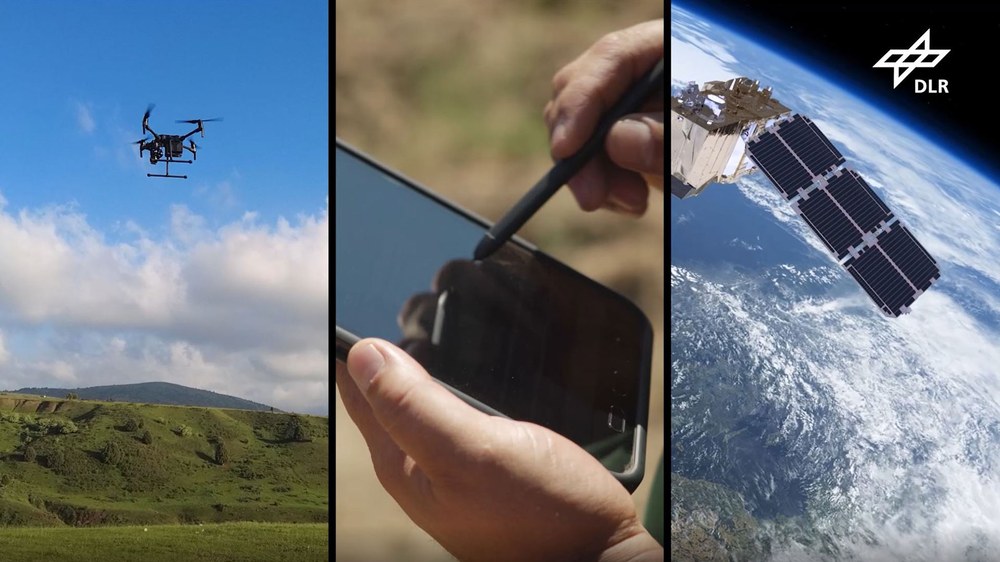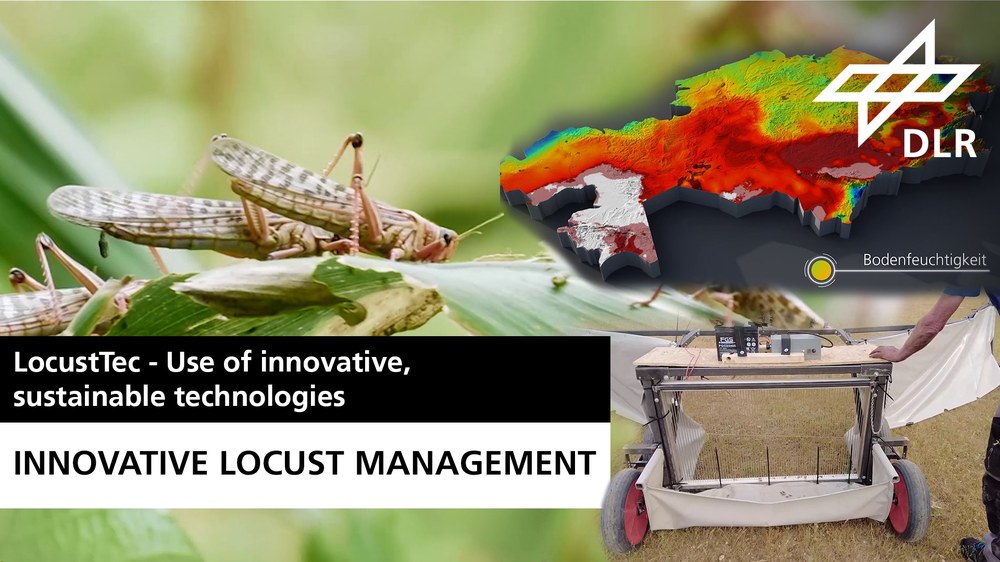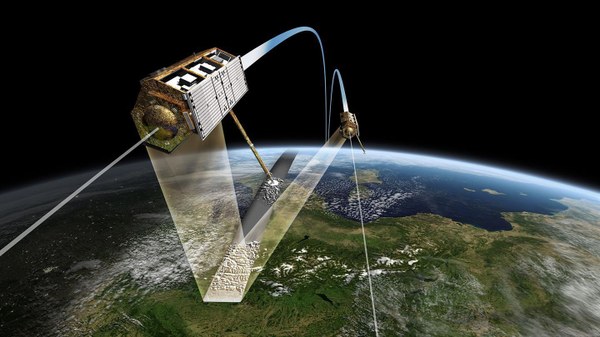Satellites detect where locust infestations begin



- Locusts spread when environmental parameters such as temperature, precipitation and vegetation density align in a favourable way.
- These environmental parameters can be monitored and evaluated via satellite data.
- The international Locust-Tec project combines methods from Earth observation, aerial drone operation and the digitalisation of data acquired on site to enable the timely initiation of appropriate countermeasures.
- Focus: Space, aeronautics, Earth observation, climate change, agriculture
Locusts can destroy grain crops and pastures, threatening people's livelihoods. In an international project, researchers from the German Aerospace Center (Deutsches Zentrum für Luft- und Raumfahrt; DLR) have now developed methods to help detect locust outbreaks as early as possible and take action against them. Earth observation images acquired by satellites play a central role in this. These images enable the early detection of environmental parameters that favour the upsurge of the insects.
"Certain conditions are important for the development of locusts," explains Igor Klein from DLR’s Earth Observation Center (EOC). "These include, for example, temperature, precipitation and soil moisture, but also the density and type of vegetation. Using Earth observation images, we can record these parameters and combine them in such a way that we can determine very precisely if a location exhibits the ideal conditions for locusts." The researchers at the EOC use a variety of satellites for this purpose, including those of the European Copernicus Earth observation programme.

Video: Locust-Tec – Introduction of innovative and environmentally friendly technologies for locust management.
Your consent to the storage of data ('cookies') is required for the playback of this video on Youtube.com. You can view and change your current data storage settings at any time under privacy.
Using these data, the researchers in the Locust-Tec project first determined the areas in which the Italian locust (Calliptamus italicus) and the Moroccan locust (Dociostaurus maroccanus) could proliferate. Their potential habitats range from Europe to China. Both locust species occur in Kazakhstan and require annual monitoring and control. The Locust-Tec project is focusing on the Central Asian country for this reason, among others. "However, further research activities would in principle allow our findings to be applied to other locust species," says Igor Klein. "In general, the environmental preferences of swarming locust species primarily endanger drylands. However, climate change could lead to additional areas being threatened in the future."
Easy data collection on site via an app
After evaluating the satellite data, the project participants determined where further analysis was needed. They then operated a drone over these areas. Its multispectral camera was used to observe the region in greater detail than is possible with the human eye. A healthy green meadow, for example, reflects strongly in the near-infrared range. If, on the other hand, the meadow is ‘stressed’ because locusts have begun to attack the blades of grass, healthy vegetation can be distinguished from damaged vegetation via infrared observations. This is because, while meadow may still appear unchanged to the human eye, the chlorophyll content has already begun to decrease.
Experts on site also entered their own observations into an app. This included measurements of the size of effected areas, the locust species present and the developmental stage and number of locusts per square metre. The app, which was created by project participants, facilitates the work of the experts and can transmit the results directly to decision-makers in a digital format. This reduces the time taken to initiate countermeasures. Local authorities are warned at a relatively early stage where the presence of locusts could develop into an outbreak.
All of the data acquired via Earth observation, from the on-site specialists via the app and from the drone surveys converge within a geographic information system (GIS) and can be displayed on maps. Gradually, time series data will reveal how this monitoring and locust management complement one another.
Seeking alternatives to pesticides
Locust management includes the implementation of countermeasures to combat impending locust outbreaks. Another aspect of the Locust-Tec project was to test environment-friendly alternative countermeasures that could be used to combat the pests in place of pesticides. The use of an electric grid, for example, appeared promising. One advantage of this method is that the locusts collected in this way could even potentially be used as a source of animal feed. "One of the project goals is to test environment-friendly methods of locust control that are less harmful to humans and the environment than conventional measures using insecticides," explains Igor Klein. "In order to apply these environmentally friendly measures, it is important that the affected areas are surveyed at an early stage."
More information
About Locust-Tec
The Locust-Tec project is funded by the Federal Ministry of Education and Research (BMBF) as part of the CLIENT II programme. It runs from 2018 to 2023 and is managed by DLR. Other project participants are the surveying office Schwing & Dr. Neureither, Quellwerke GmbH, Horizont group GmbH, Prof. Dr. Frithjof Voss Foundation, the Kazakh Plant protection and Quarantine Institute and the Republican Methodological Center of Phytosanitary, Diagnostics and Forecasts.

